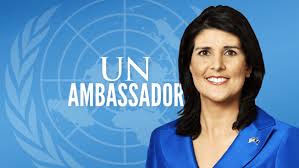
A simplistic yet realistic view of the narrowness of Israel’s “waistband”, and the topographic reality of the high land of Judea and Samaria overlooking Israel’s coastal plain Continue reading

A simplistic yet realistic view of the narrowness of Israel’s “waistband”, and the topographic reality of the high land of Judea and Samaria overlooking Israel’s coastal plain Continue reading
 President Trump may have made some questionable appointments during his first two months in office, but one can only have glowing words for the new US Ambassador to the UN, Nikki Haley. Haley hit the ground running, letting the world know that she was no pushover. At the AIPAC conference in Washington DC yesterday, Ambassador Haley was asked how the United States can help change the culture at the UN. Her response is one for the books:
President Trump may have made some questionable appointments during his first two months in office, but one can only have glowing words for the new US Ambassador to the UN, Nikki Haley. Haley hit the ground running, letting the world know that she was no pushover. At the AIPAC conference in Washington DC yesterday, Ambassador Haley was asked how the United States can help change the culture at the UN. Her response is one for the books:
“The United States tells them what we’re not going to put up with. We start to change the culture to what we should be talking about and then we actually act on what we say.”
“I wear heels. It’s not for a fashion statement. It’s because if I see something wrong, we’re going to kick them every single time.” Continue reading
This year’s AIPAC conference in Washington D.C. is in full swing and AFSI is well represented. Judy Kadish, AFSI’s Co-Executive Director attended the YESHA Sovereignty Session, and is seen here with the Women In Green’s Sovereignty journal. Continue reading
Am Echad, Lev Echad – One People, One Heart
Historical voting patterns show clearly that an overwhelming percent of American Jews vote for the Democratic candidate for president, typically 70-80%. The latest election was no exception. Continue reading
Community of Efrat,
south of Jerusalem, between Hebron and Bethlehem
Soon enough, details will emerge about the meetings being held between U.S. administration officials and Israeli leadership. The press is reporting that the two parties are nearing an agreement on a slowdown in Israeli “settlement” growth in Judea and Samaria, with PM Netanyahu rejecting any claims of limitations on Jewish development and growth in Jerusalem. Continue reading
E-1, between Jerusalem and Ma’ale Adumim
(Map: Israel Hayom)
Israel Hayom published a piece a few days ago by journalist and commentator David Weinberg about the importance of the E-1 area east of Jerusalem. This piece of land, in Area C and thus under full Israeli jurisdiction, is considered critical for Israel to maintain, control and develop for several reasons, including demographic and strategic/security. Continue reading
AFSI welcomes the announcement earlier this week of four new appointments to Israel’s Supreme Court, who will replace justices due to retire in the coming year. The four are:
– Jerusalem District Court Judge David Mintz
– Haifa District Court President Yosef Elron Continue reading
Just weeks after the state destroyed homes in Amona and evicted its residents, nine homes in nearby Ofra are targeted for demolition. New homes have not yet been built for the Amona residents, and it is anticipated that the Regulations Law recently passed will be found “unconstitutional”, even though Israel does not have a constitution Continue reading
Yesterday we reported on Israel’s High Court rejecting the petition by Ofra residents not to demolish nine homes slated for demolition. The judges did not accept the request of the residents to seal the nine houses rather than demolish them, and also clarified that the recently approved Regulation Law did not apply to them. Continue reading